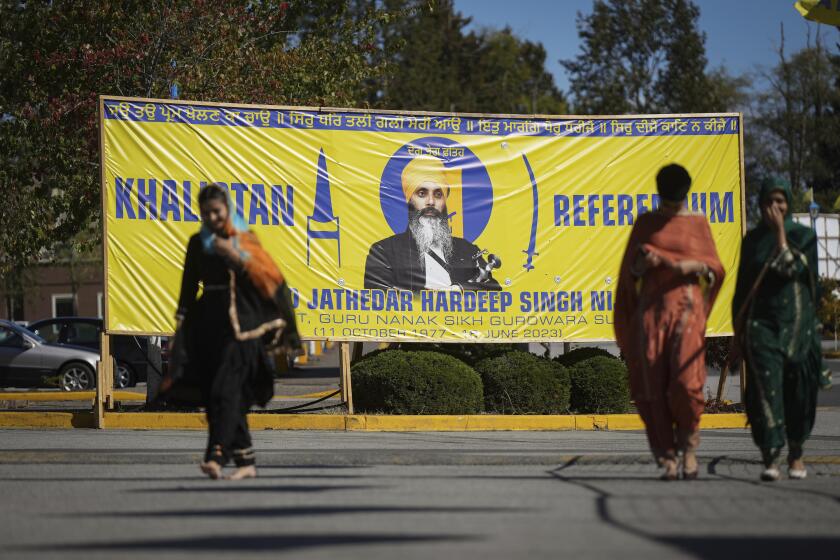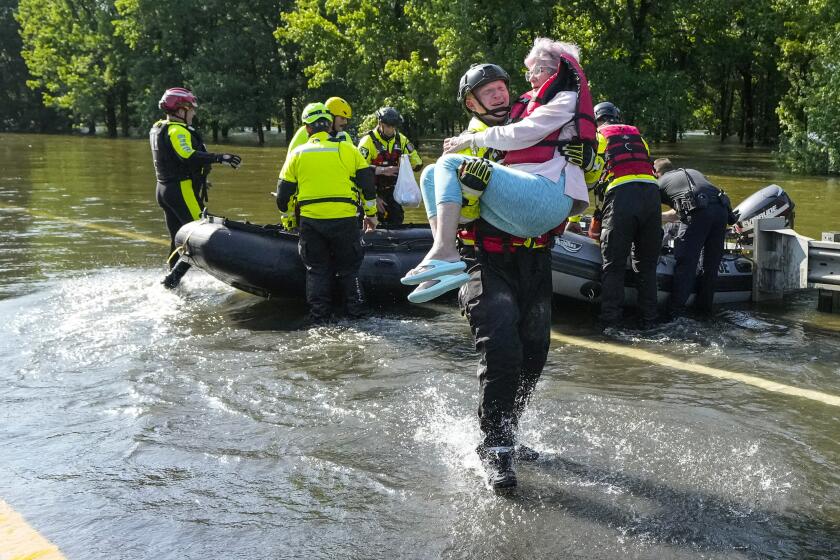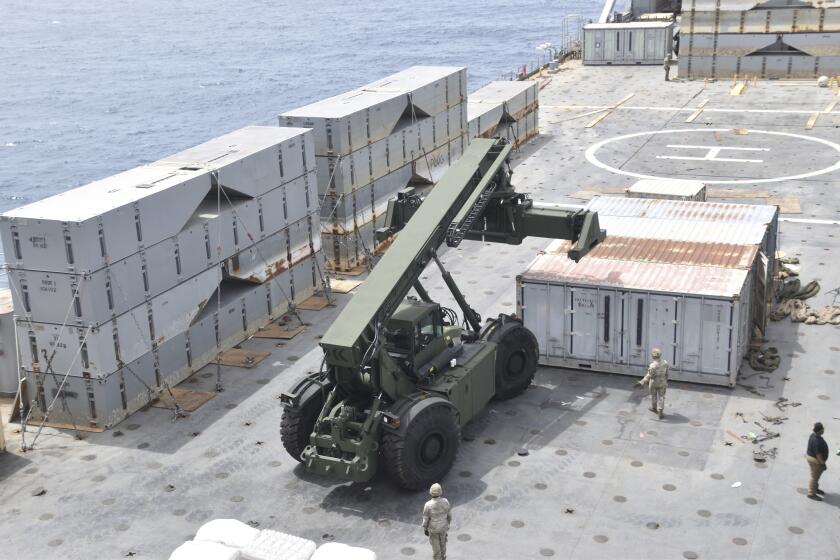U.S. Now Wages a War of Nerves Against Iraq
And so they sit: 32,000 troops; two aircraft carriers; 350 warplanes, including eight radar-defying stealth fighters; 235 tanks or fighting vehicles; and a missile-equipped attack submarine. With the U.S. deployment on Iraq’s periphery now complete, the familiar dilemma for the White House becomes: What’s next?
For the time being, anyway, Iraqi President Saddam Hussein appears to have pulled back.
His troops have withdrawn from Irbil, the capital of the Kurdish north captured late last month by Kurds allied with Baghdad. His Russian-manufactured missiles are no longer targeting U.S. warplanes. He has even moved some of his equipment out of an expanded “no-fly” zone in southern Iraq.
The issue now is how long the United States maintains a beefed-up presence in the Persian Gulf region--with the meter running. Staying may prove difficult to justify.
So far, the latest deployment adds a minimum of $3 million a day above normal expenses for troops and equipment on top of another $3 million a day for what has been sent to the Gulf region since 1991’s “Operation Desert Storm,” according to estimates by the Center for Defense Information in Washington.
And unlike Iraqi ploys in 1992 and 1994, this time there was never a threat on the ground to America’s oil suppliers in the Gulf emirates.
Yet leaving may tempt fate--and Hussein. For the Clinton administration, the basic problem, like the Persian Gulf War and the subsequent buildups, is that there is still no end game in sight.
“People are asking the same questions today they asked in 1991: What’s Saddam doing, and what can we do about it?” said Phebe Marr, an Iraq specialist at National Defense University in Washington. “There are no good, easy or cheap solutions. Most options are unpalatable, so we keep doing the same thing because there’s nothing better.”
*
Although CIA Director John M. Deutch admitted last week that this month’s face-off amounted to a victory for Baghdad, U.S. strategy has only been slightly altered, Pentagon officials say. It still centers on four goals:
* Sustaining a strong forward military presence, the linchpin of which is “Operation Southern Watch” in the south of Iraq, to enable the United States to protect Saudi Arabia and Kuwait.
* Maintaining U.N. sanctions so that Hussein is unable to rebuild his army or become a regional financial power.
* Pressing U.N. arms monitors to trace and destroy Baghdad’s nuclear, chemical and biological weapons of mass destruction and his long-range missiles.
* Encouraging the Iraqi opposition.
“Our strategy is containment, to keep him weak, so that he is not a threat through nukes or oil,” a senior Pentagon official said.
The only substantive variation in American strategy is less emphasis on “Operation Provide Comfort” in the Kurdish north, although Washington is reaching out to Democratic Party of Kurdistan leader Masoud Barzani to try to wean him from his new alliance with Baghdad.
Pentagon officials now estimate that much of the additional American might will remain in the region for several weeks--”until we have a sense that he is prepared to comply with all our warnings,” the Pentagon source said.
*
For the Clinton administration, the pressing question is whether Baghdad intends to issue another challenge before the November election. For more than six months, U.S. intelligence has predicted that Hussein would try to play with the American political season--as he did before the 1992 and 1994 votes.
U.S. officials now differ on whether the Iraqi regime will try something again. Rather than risk being caught out, U.S. reinforcements may stay through election day “to be on the safe side,” the Pentagon official added.
And then?
Although there is growing sympathy for Iraq and even Hussein in the Middle East, U.S. and British officials say they do not believe that there is any prospect of compromise that would allow Iraq, under the current leadership, to return as a regular member of the international community.
“Nothing suggests that he is contrite about what has happened or that he sees his interests or survival in terms of compliance with the U.N. resolutions,” a British envoy said.
Added Marr: “The man is technically incorrigible. You may get tactical compliance whereby you push him and he’ll push his troops back. But he’ll still be strategically defiant and not change his goals or his modus operandi.”
In dealing with Iraq, the central problem is a long-standing contradiction between the U.S. mandate and the implicit U.S. goal.
For six years, Washington has spearheaded an international effort to draw a line in the sand that will protect vulnerable sheikdoms that supply oil to the West. The international mandate is defensive.
But the U.S. goal under Republican and Democratic presidents has tacitly been offensive: to remove Hussein from power.
“As long as he is in power he is almost certainly going to be a threat to U.S. interests; therefore, we would like to see someone else leading Iraq,” a U.S. policymaker acknowledged.
The United States now faces two long-term options, Marr said. Both have serious downsides.
The first is that Hussein is forced from power.
“The costs and risks are huge, and then there’s the danger of what you could get stuck with after. It might even be worse,” she said.
The second is accepting the fact that Hussein is going to last for a considerable time and then crafting policy accordingly. This is a strategy that is at least as costly to the United States and the Iraqi people as to Hussein, who has managed since the Gulf War to build several palaces while Iraqis suffered the consequences of economic sanctions.
Indeed, the longer the overall U.S. deployment becomes, the more the cost-benefit ratio may come into question, according to retired Adm. Eugene Carroll of the Center for Defense Information.
“The American people don’t realize we’re providing security for the rest of the world at taxpayers’ expense--when Japan imports most of its oil from the Mideast and Europe gets some 30%,” Carroll said. “We’re providing the leadership, military personnel and dollars, and they’re now getting a free ride.”
The costs are not just financial.
Only five years ago, the United States was the savior of the Gulf, commander of the most impressive international coalition in half a century. This time, the Arab League has questioned the U.S. action, and even some allies have suggested that Washington was trigger-happy or engaged in overkill.
The bottom line, analysts inside and outside government suggest, is that the United States must lower its expectations.
In a reflection of how much has changed since the stunning successes in the Arabian sands, a Pentagon official advised: “We should be realistic about how much we as outsiders can influence events.”
More to Read
Start your day right
Sign up for Essential California for news, features and recommendations from the L.A. Times and beyond in your inbox six days a week.
You may occasionally receive promotional content from the Los Angeles Times.






